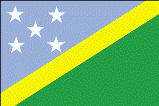|
Solomon Islands
|

|
Capital: Honiara
Population: 669,823
Brief History of Solomon Islands:
The Solomon Islands is an island country located in the Pacific Ocean northeast of Australia. There are over 1,000 islands that make up the country. Honiara, the capital of the Solomon Islands, is on the largest island called Guadalcanal.
The islands were first inhabited by tribal peoples as early as 1000 BC. The first European to discover the islands was Spanish explorer Alvaro de Mendana Y Neyra in 1567. He was searching for the legendary treasure and Isles of Solomon.
It was many years later in the 1800s when more people began to arrive and try to settle on the Solomon Islands. In 1900 the British took control of the islands.
The Solomon Islands were an area of fierce fighting between the United States and Japan during World War II. Over 21,000 Japanese and 7,000 Americans were killed in battles on the islands. The Allies finally gained control in December of 1943. In 1978 the country became fully independent.
The Geography of Solomon Islands
Total Size: 28,450 square km
Size Comparison: slightly smaller than Maryland
Geographical Coordinates: 8 00 S, 159 00 E
World Region or Continent: Oceania
General Terrain: mostly rugged mountains with some low coral atolls
Geographical Low Point: Pacific Ocean 0 m
Geographical High Point: Mount Makarakomburu 2,447 m
Climate: tropical monsoon; few extremes of temperature and weather
Major cities: HONIARA (capital) 72,000 (2009)
The People of Solomon Islands
Type of Government: parliamentary democracy
Languages Spoken: Melanesian pidgin in much of the country is lingua franca; English is official but spoken by only 1%-2% of the population
Independence: 7 July 1978 (from UK)
National Holiday: Independence Day, 7 July (1978)
Nationality: Solomon Islander(s)
Religions: Church of Melanesia 32.8%, Roman Catholic 19%, South Seas Evangelical 17%, Seventh-Day Adventist 11.2%, United Church 10.3%, Christian Fellowship Church 2.4%, other Christian 4.4%, other 2.4%, unspecified 0.3%, none 0.2% (1999 census)
National Symbol:
National Anthem or Song: God Save Our Solomon Islands
Economy of Solomon Islands
Major Industries: fish (tuna), mining, timber
Agricultural Products: cocoa beans, coconuts, palm kernels, rice, potatoes, vegetables, fruit; timber; cattle, pigs; fish
Natural Resources: fish, forests, gold, bauxite, phosphates, lead, zinc, nickel
Major Exports: timber, fish, copra, palm oil, cocoa
Major Imports: food, plant and equipment, manufactured goods, fuels, chemicals
Currency: Solomon Islands dollar (SBD)
National GDP: $1,761,000,000
** Source for population (2012 est.) and GDP (2011 est.) is CIA World Factbook.
Back to Geography Home Page
